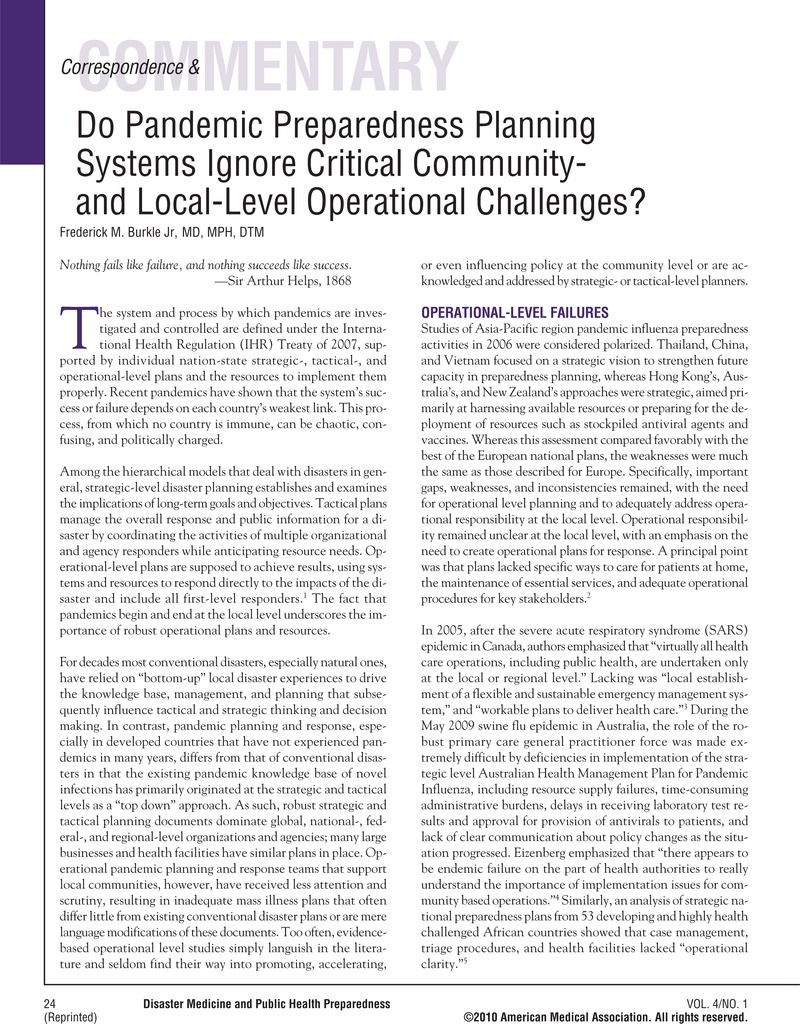Crossref Citations
This article has been cited by the following publications. This list is generated based on data provided by Crossref.
Burkle, Frederick M.
Williams, Alcia
and
Kissoon, Niranjan
2011.
Pediatric emergency mass critical care: The role of community preparedness in conserving critical care resources.
Pediatric Critical Care Medicine,
Vol. 12,
Issue. ,
p.
S141.
Burkle, Frederick M.
2011.
The Limits to Our Capacity: Reflections on Resiliency, Community Engagement, and Recovery in 21st-Century Crises.
Disaster Medicine and Public Health Preparedness,
Vol. 5,
Issue. S2,
p.
S176.
Turner, Anne M.
Reeder, Blaine
and
Wallace, James C.
2013.
A Resource Management Tool for Public Health Continuity of Operations During Disasters.
Disaster Medicine and Public Health Preparedness,
Vol. 7,
Issue. 2,
p.
146.
Geiling, James
Burkle, Frederick M.
Amundson, Dennis
Dominguez-Cherit, Guillermo
Gomersall, Charles D.
Lim, Matthew L.
Luyckx, Valerie
Sarani, Babak
Uyeki, Timothy M.
West, T. Eoin
Christian, Michael D.
Devereaux, Asha V.
Dichter, Jeffrey R.
and
Kissoon, Niranjan
2014.
Resource-Poor Settings: Infrastructure and Capacity Building.
Chest,
Vol. 146,
Issue. 4,
p.
e156S.
Reaves, Erik J.
Termini, Michael
and
Burkle, Frederick M.
2014.
Reshaping US Navy Pacific Response in Mitigating Disaster Risk in South Pacific Island Nations: Adopting Community-Based Disaster Cycle Management.
Prehospital and Disaster Medicine,
Vol. 29,
Issue. 1,
p.
60.
Geiling, James
Burkle, Frederick M.
West, T. Eoin
Uyeki, Timothy M.
Amundson, Dennis
Dominguez-Cherit, Guillermo
Gomersall, Charles D.
Lim, Matthew L.
Luyckx, Valerie
Sarani, Babak
Christian, Michael D.
Devereaux, Asha V.
Dichter, Jeffrey R.
and
Kissoon, Niranjan
2014.
Resource-Poor Settings: Response, Recovery, and Research.
Chest,
Vol. 146,
Issue. 4,
p.
e168S.
Canyon, Deon V.
Burkle, Frederick M.
and
Speare, Rick
2015.
Managing Community Resilience to Climate Extremes, Rapid Unsustainable Urbanization, Emergencies of Scarcity, and Biodiversity Crises by Use of a Disaster Risk Reduction Bank.
Disaster Medicine and Public Health Preparedness,
Vol. 9,
Issue. 6,
p.
619.
Burkle, Frederick M.
2015.
Operationalizing Public Health Skills to Resource Poor Settings: Is This the Achilles Heel in the Ebola Epidemic Campaign?.
Disaster Medicine and Public Health Preparedness,
Vol. 9,
Issue. 1,
p.
44.
Burkle, Frederick M.
2016.
Zika: Defining the Public Health and Exposing its Vulnerabilities.
Disaster Medicine and Public Health Preparedness,
Vol. 10,
Issue. 2,
p.
296.
Purohit, Vidula
Kudale, Abhay
Sundaram, Neisha
Joseph, Saju
Schaetti, Christian
and
Weiss, Mitchell G.
2017.
Public Health Policy and Experience of the 2009 H1N1 Influenza Pandemic in Pune, India.
International Journal of Health Policy and Management,
Vol. 7,
Issue. 2,
p.
154.
Rozenfeld, Ranna A.
Reynolds, Sally L.
Ewing, Sherri
Crulcich, Mary Margaret
and
Stephenson, Michelle
2017.
Development of an Evacuation Tool to Facilitate Disaster Preparedness: Use in a Planned Evacuation to Support a Hospital Move.
Disaster Medicine and Public Health Preparedness,
Vol. 11,
Issue. 4,
p.
479.
Burkle, Frederick M.
2019.
Current Crises and Potential Conflicts in Asia and the Pacific: Challenges Facing Global Health or Global Public Health by a Different Name.
Prehospital and Disaster Medicine,
Vol. 34,
Issue. 6,
p.
653.
Menoni, Scira
2021.
COVID-19: Systemic Risk and Resilience.
p.
75.
Shufutinsky, Anton
Long, Bena
Sibel, James R.
and
Burrell, Darrell Norman
2021.
Global Perspectives on Change Management and Leadership in the Post-COVID-19 Era.
p.
136.
Banerjee, Debanjan
and
Meena, K. S.
2021.
RETRACTED: COVID-19 as an “Infodemic” in Public Health: Critical Role of the Social Media.
Frontiers in Public Health,
Vol. 9,
Issue. ,
de Waal, André
Linthorst, Julie
and
Hetterschijt, Caroline
2021.
Lessons Learned by Organisations during the COVID-19 Pandemic.
International Journal of Management and Applied Research,
Vol. 8,
Issue. 1,
p.
72.
AlAssaf, Wajdan
2022.
Challenges in Pandemic Disaster Preparedness: Experience of a Saudi Academic Medical Center.
Disaster Medicine and Public Health Preparedness,
Vol. 16,
Issue. 1,
p.
285.



